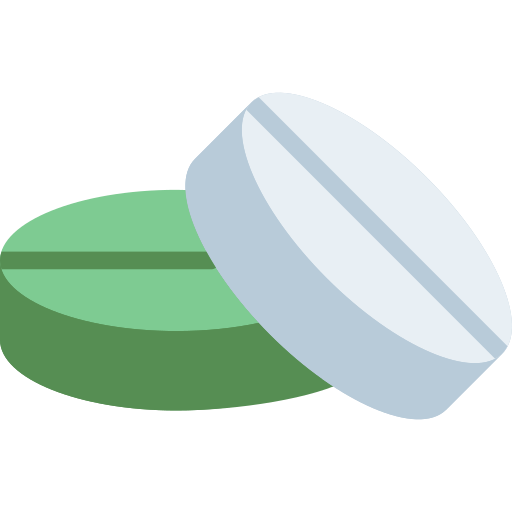
Terbinafine Hydrochloride
250 mg
Square Pharmaceuticals Ltd.
Product Details
Description
Terbinafine, an Allylamine antifungal, inhibits biosynthesis of Ergosterol (an essential component of fungai cell membrane) via inhibition of Squalene Epoxidase enzyme. This results in fungal cell death primarily due to the increased membrane permeability mediated by the accumulation of high concentrations of Squalene but not due to Ergosterol deficiency. Depending on the concentration of the drug and the fungal species test in vitro, Terbinafine hydrochloride may be fungicidal. However, the clinical significance of in vitro data is unknown. Terbinafine has been shown to be active against most strains of the following microorganisms both in vitro and in clinical infections: Tricophyton Mentagrophyte, Trichophyton Rubrum.
Terbinafine tablet: This tablet is indicated for the treatment of onychomycosis of the toenail or fingernail due to dermatophytes (tinea unguium). Terbinafine granules: This is indicated in Tinea Capitis. Terbinafine cream: Fungal infection of the skin caused by Trichophyton (e.g. T. rubrum, T. mentagrophytes, T. verrucosum, T. violaceum), Microsporum canis and Epidermophyton floccosum. Yeast infections of the skin, principally those caused by the genus Candida (e.g. C. albicans). Pityriasis (tinea) versicolor due to Pityrosporum orbicular (also known as Malassezia furfur). Terbinafine 1% Spray: This spray is indicated in the treatment of tinea infections of the skin. This spray is also indicated in the treatment of pityriasis (tinea) versicolor due to Malassezia furfur.
Terbinafine tablet and cream are contra-indicated in individuals with hypersensitive to terbinafine.
The adverse events reported encompass gastrointestinal symptoms (including diarrhea, dyspepsia and abdominal pain), liver test abnormalities, rashes, urticaria, pruritus, and taste disturbances. In general, the adverse events were mild, transient, and did not lead to discontinuation. Adverse events, based on worldwide experience with terbinafine use, include: idiosyncratic and symptomatic hepatic injury and more rarely, cases of liver failure, some leading to death or liver transplant, serious skin reactions, severe neutropenia, thrombocytopenia, angioedema and allergic reactions (including anaphylaxis). Other adverse reactions that have been reported include malaise, fatigue, vomiting, arthralgia, myalgia, and hair loss.
Terbinafine tablet: There are no adequate and well-controlled studies in pregnant women. Because animal reproduction studies are not always predictive of human response, and because treatment of onychomycosis can be postponed until after pregnancy is completed, it is recommended that terbinafine not be initiated during pregnancy. After oral administration, terbinafine is present in the breast milk of nursing mothers. Treatment with terbinafine is not recommended in nursing mothers. Terbinafine cream: Foetal toxicity and fertility studies in animals suggest no adverse effects. There is no clinical experience with terbinafine in pregnant women; therefore, unless the potential benefits outweigh any potential risk, terbinafine should not be administered. Terbinafine is excreted in breast milk and therefore mothers should not receive terbinafine treatment whilst breast-feeding.
Warnings- Terbinafine tablets: Rare cases of liver failure, some leading to death or liver transplant, have occurred with the use of terbinafine tablets for the treatment of onychomycosis in individuals with and without preexisting liver disease. In the majority of liver cases reported in association with terbinafine use, the patients had serious underlying systemic conditions and an uncertain causal association with terbinafine. The severity of hepatic events and/or their outcome may be worse in patients with active or chronic liver disease. Treatment with terbinafine tablets should be discontinued if there is biochemical or clinical evidence of liver injury. There have been isolated reports of serious skin reaction (e.g., Stevens-Johnson Syndrome and toxic epidermal necrolysis). If progressive skin rash occurs, treatment with terbinafine should be discontinued. Terbinafine cream: Terbinafine cream is for external use only. Contact with the eyes should be avoided. Precautions: Terbinafine are not recommended for patients with chronic or active liver disease. Before prescribing Terbinafine, pre-existing liver disease should be assessed. Hepatotoxicity may occur in patients with and without pre-existing liver disease. Pretreatment serum transaminase (ALT and AST) teste are advised for all patients before taking terbinafine tablets.
Pediatric use: The safety and efficacy of terbinafine have not been established in pediatric patients. Use in the elderly: There is no evidence to suggest that elderly patients require different dosages or experience side-effects different to those of younger patients.
Clinical experience regarding overdose with terbinafine tablets is limited. Doses up to 5 gm (20 times the therapeutic daily dose) have been taken without inducing serious adverse reactions. The symptoms of overdose included nausea, vomiting, abdominal pain, dizziness, rash, frequent urination, and headache.
Other Antifungal preparations, Topical Antifungal preparations
-
Support 24/7
Call us anytime -
100% Safety
Only secure payments